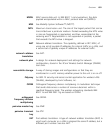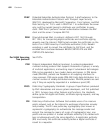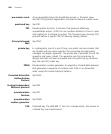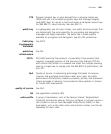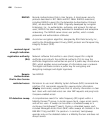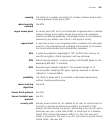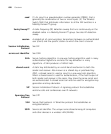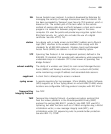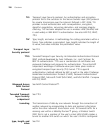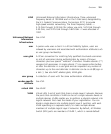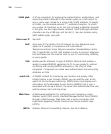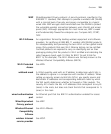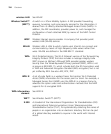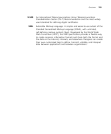GLOSSARY 699
SSL Secure Sockets Layer protocol. A protocol developed by Netscape for
managing the security of message transmission over the Internet. SSL
has been succeeded by Transport Layer Security (TLS) protocol, which is
based on SSL. The sockets part of the term refers to the sockets
method of passing data back and forth between a client and a server
program in a network or between program layers in the same
computer. SSL uses the public-and-private key encryption system from
RSA Data Security, Inc., which also includes the use of a digital
certificate. See also HTTPS; TLS.
station Any device with a media access control (MAC) address and a Physical
layer (PHY) interface to the wireless medium that comply with the
standards for all IEEE 802 networks. Wireless clients and Managed
Access Points (MAPs) are stations in a 3Com Mobility System.
STP Spanning Tree Protocol. A link management protocol, defined in the
IEEE 802.1D standard, that provides path redundancy while preventing
undesirable loops in a network. STP is also known as Spanning Tree
Bridge Protocol.
subnet mobility The ability of a wireless user (client) to roam across Managed Access
Points (MAPs) and Wireless Switches (WXs) in a virtual LAN (VLAN)
while maintaining a single IP address and associated data sessions.
supplicant A client that is attempting to access a network.
syslog server A remote repository for log messages. 3Com Mobility System Software
(MSS) supports up to four syslog servers on virtual LANs (VLANs) whose
locations are configurable. MSS log protocol complies with RFC 3164.
Temporal Key
Integrity Protocol
See TKIP.
TKIP Temporal Key Integrity Protocol. A wireless encryption protocol that
fixes the known problems in the Wired-Equivalent Privacy (WEP)
protocol for existing IEEE 802.11 products. Like WEP, TKIP uses RC4
ciphering, but adds functions such as a 128-bit encryption key, a 48-bit
initialization vector, a new message integrity code (MIC), and
initialization vector (IV) sequencing rules to provide better protection.
See also 802.11i; CCMP.



